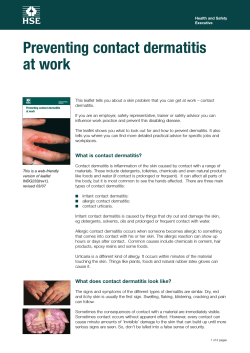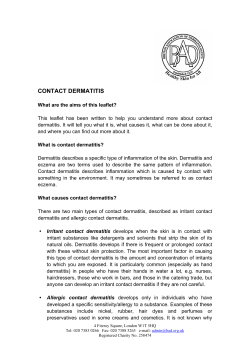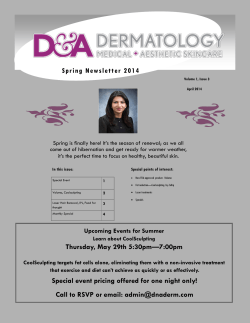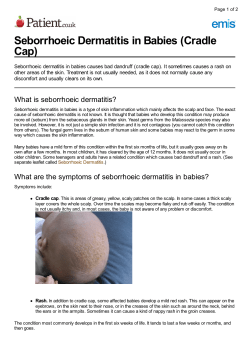
Atopic Dermatitis, Contact Dermatitis, and Eczema
BIO Atopic Dermatitis, Contact Dermatitis, and Eczema (Rashes) D. Kishore Yellumahanthi, MD, MPH CME073 Wednesday, 9:15-10:15 a.m., Location: 151AB CME074 Wednesday, 1:45-2:45 p.m., Location: 151AB ACTIVITY DISCLAIMER The material presented here is being made available by the American Academy of Family Physicians for educational purposes only. This material is not intended to represent the only, nor necessarily best, methods or procedures appropriate for the medical situations discussed. Rather, it is intended to present an approach, view, statement, or opinion of the faculty, which may be helpful to others who face similar situations. The AAFP disclaims any and all liability for injury or other damages resulting to any individual using this material and for all claims that might arise out of the use of the techniques demonstrated therein by such individuals, whether these claims shall be asserted by a physician or any other person. Every effort has been made to ensure the accuracy of the data presented here. Physicians may care to check specific details such as drug doses and contraindications, etc., in standard sources prior to clinical application. This material might contain recommendations/guidelines developed by other organizations. Please note that although these guidelines might be included, this does not necessarily imply the endorsement by the AAFP. • A board certified family physician • completed residency in dermatology in India and practiced as consultant dermatologist • MPH from University of Alabama at Birmingham, AL • written numerous journal articles • Lectured on a range of topics including tropical infectious diseases, HCV and lichen planus, and HIV infection. • Currently, I practice family medicine at Huntsville Hospital, in Huntsville, Alabama, and in a hospitalaffiliated practice in Gurley, Alabama. Learning Objectives 1. Compare symptomatology of the different types of eczema and dermatitis. 2. Counsel patients on lifestyle modifications to control flare-ups and triggers for atopic dermatitis and contact dermatitis. 3. Recognize when patients require patch testing to confirm or rule out allergic contact dermatitis. 4. Create a disease management strategy for patients with eczema and dermatitis based on the type and severity of the condition. FACULTY DISCLOSURE It is the policy of the AAFP that all individuals in a position to control content disclose any relationships with commercial interests upon nomination/invitation of participation. Disclosure documents are reviewed for potential conflict of interest (COI), and if identified, conflicts are resolved prior to confirmation of participation. Only those participants who had no conflict of interest or who agreed to an identified resolution process prior to their participation were involved in this CME activity. All faculty in a position to control content for this session have indicated they have no relevant financial relationships to disclose. Agenda •Classification of Eczema •Atopic Dermatitis •Contact Dermatitis The content of my material/presentation in this CME activity will not include discussion of unapproved or investigational uses of products or devices. 1 What is Eczema? • Clinical and histological pattern of inflammation of the skin seen in a variety of dermatoses wih widely diverse etiologies. • Clinically, eczematous dermatoses are characterized by variable intensity of itching and soreness and in variable degrees, a range of signs including dryness, erythema, excoriation, exuation, fissuring, hyperkeratosis, lichenification, papulation, scaling and vesiculation. Rook’s Textbook of Dermatology Learning Objectives/Goals 1. Compare symptomatology of the different types of eczema and dermatitis. 2. Counsel patients on lifestyle modifications to control flare-ups and triggers for atopic dermatitis and contact dermatitis. 3. Recognize when patients require patch testing to confirm or rule out allergic contact dermatitis. 4. Create a disease management strategy for patients with eczema and dermatitis based on the type and severity of the condition. 30 year old female has the following rash since a month or so. Mild itching. Has similar rash on the face and in the pubic area. Common types of Eczema Common types of Eczema Endogenous Exogenous Atopic dermatitis Contact dermatitis Seborrheic dermatitis P. alba Asteotic eczema Hand eczema ………………… • A. Seborrheic dermatitis • B. Psoriasis • C. Dermatophytosis • D. Polymorphic light eruption (PMLE) 35 year old has been having the following rash for the last 6 months or so. Similar,lesions are also present elsewhere on the body predominantly in the areas covered by clothes. • A. Seborrheic dermatitis • B. Psoriasis • C. Allergic contact dermatitis • D. Polymorphic light eruption (PMLE) 2 15 year old boy has this rash since 3 months or so. Has similar rash on the face and flexors of elbow. Lesions were few initially and has been getting worse. Mom thinks child had been to his Dad’s place 3 months ago and thinks he caught it from his step sister • A. Seborrheic dermatitis • B. Atopic dermatitis • C. Allergic contact dermatitis • D. lichen simplex chronicus 10 year old boy has this rash since more than 6 months or so. Asymptomatic. Few lesions are also present on the other forearm, trunk and face. Mom thinks that, of late they have become more conspicous and in the past they were little bit pink (erythematous) and scaly • Contact dermatitis • Polymorphic light eruption • Pityriasis alba • Pityriasis rosea 40 year old male has the following itchy lesion for the past one year or so. Has no lesions elsewhere. D@nderm • A. Seborrheic dermatitis • B. Psoriasis • C. Lichen Simplex Chronicus • D. Polymorphic light eruption (PMLE) History and Clinical examination is the key to diagnosis of eczema. Diagnosis of Eczema – History taking • Duration • Sites of involvement • Symptom • Anybody else at home with similar complaint • Co morbid conditions • Similar complaints in the past • If had used any topical medications already for the rash Diagnosis of Eczema – History taking • Seborrheic dermatitis - scalp, eyebrows, glabella, post auricular region, nasolabial folds, front of chest, interscapular area • Atopic dermatitis - flexural areas, associated features • Lichen simplex chronicus - accessible area for scratching. Usually solitary • P.alba – often on face Why is contact dermatitis a difficult diagnosis to make? 3 Seborrheic Dermatitis Seborrheic Dermatitis • Malassezia furfur. • Erythematous, sharply marginated lesions covered with greasy-looking scales • Scalp, eyebrows, glabella, post auricular region, nasolabial folds, front of chest, interscapular area Seborrheic Dermatitis Asteotic Eczema • Seen in elderly • Associated with very dry skin • Legs, arms and hands • Parchment like pattern Seborrheic Dermatitis Asteotic eczema 4 Asteotic eczema Hand Eczema Pityriasis alba Hand eczema • Children 3-16 years • hypopigmented patch. • Usually several patches • Course is variable P. alba Hand eczema 5 Lichen Simplex Chronicus Lichen Simplex Chronicus Atopic Dermatitis Learning Objectives/Goals 1. Compare symptomatology of the different types of eczema and dermatitis. 2. Counsel patients on lifestyle modifications to control flare-ups and triggers for atopic dermatitis and contact dermatitis. 3. Recognize when patients require patch testing to confirm or rule out allergic contact dermatitis. 4. Create a disease management strategy for patients with eczema and dermatitis based on the type and severity of the condition. Lichen Simplex Chronicus What is Atopic Dermatitis? • Itchy, Chronic, inflammatory • Characterized by itchy papules which become excoriated and lichenified • Typically have flexural distribution • Frequent association with other atopic conditions 6 Atopic Dermatitis – Etiology & pathogenesis • Allergies, infections, emotional, climatic and other environmental influences • Epithelia have significant impairments of innate antimicrobial defences • Colonization of skin by S.aureus exacebates eczema • Food allergens and airborne allergens Atopic Dermatitis – diagnosis.. • Hanifin and Rajka’s diagnostic criteria, the child must have • An itchy skin condition (or a parental report of scratching or rubbing a child) • Plus 3 or more of the below: 1. Onset below 2years (not used if child is under 4yrs) 2. History of skin crease involvement Atopic Dermatitis – clinical features • Infantile • Childhood • Adolescent& adult Atopic Dermatitis – clinical features • Infantile – erythema of the face and then as child starts crawling more exposed parts are involved • Onset after 2 months. • Childhood :18-24 months • Flexural distribution – elbow, knee, ankle, wrist, sides of the neck …Atopic Dermatitis - diagnosis Atopic Dermatitis – clinical features 3. History of a generally dry skin 4. Personal history of other atopic disease (or history of any atopic disease in a first degree relative in children under 4 years) 5. Visible flexural dermatitis (or dermatitis of cheeks/forehead and other limbs in children under 4 years) • Adult – lichenification in the flexures • Lichenified follicular papules • Localized distribution • Complications – secondary infection, psychosocial aspects • Prognosis – Tendency towards spontaneous improvement throughout childhood 7 Atopic Dermatitis Atopic Dermatitis Atopic Dermatitis Atopic Dermatitis Atopic Dermatitis Atopic Dermatitis – Management • Initial treatment – patient education, avoiding or reduction of trigger factors, use of emolients and topical steroids. • Patient education – updated knowledge of the disease, various trigger factors, therapeutic options and their pros and cons. • Trigger factors – several – scratching, wool clothing, stress, skin infections, food allergens to name few. 8 Atopic Dermatitis – Management • Reduction of trigger factors - dispersible cream can be used as a soap substitute to cleanse the skin - Reducing/turning down the central heating - Not heating the bed room - Wearing cotton clothing - Food allergens Atopic Dermatitis – Management • For maintenance therapy, low corticosteroids • Oral antihistamines, antibiotics • Topocal calcineurin inhibitors Learning Objectives/Goals 1. Compare symptomatology of the different types of eczema and dermatitis. 2. Counsel patients on lifestyle modifications to control flare-ups and triggers for atopic dermatitis and contact dermatitis. 3. Recognize when patients require patch testing to confirm or rule out allergic contact dermatitis. 4. Create a disease management strategy for patients with eczema and dermatitis based on the type and severity of the condition. Contact Dermatitis IRRITANT DERMATITIS Can occur in any individual Acids, alkalis, animals.. ALLERGIC CONTACT DERMATITIS Occurs only in those who are previously sensitized to the allergen Cell mediated immunity or hypersensitivity Allergic Contact Dermatitis Contact Dermatitis • Can mimic or be associated with any type of eczematous eruption • Careful history & sound knowledge of common allergens and irritants Poison ivy, nickel,balsam of peru, neomycin, fragrance, thimerosal, gold, formaldehyde , bacitracin, rubber compounds 9 ACD to paraphenylene diamine Patch testing • Small amounts of suspected allergens are placed onto tape and then applied to the patient’s back • The tape is removed after 48hrs and a reading is made to check for reactions (erythematous spot at the location of particular allergen) • Pt is made to return again at day 4 or 5 ACD to fragrance in a detergent THIN-LAYER RAPID USE EPICUTANEOUS PATCH TEST- T.R.U.E. TEST • Easy to use patch test • 3 test panels consisting of 35 different substances known to cause contact dermatitis • If negative and you still suspect contact dermatitis, requires additional testing • Positive reactions need to be confirmed by patient history and symptoms. ACD to toluene sulfonyl urea in nail varnish When do we need patch testing? 10 When do we need patch testing? Allergic Contact Dermatitis • The contact allergen avoidance data base (CARD) provide names of alternative products. When do we need patch testing? Management of Eczema • Patient education • Avoid or reduce trigger factors • Topical steroids – strength depends on severity of the eczema, site of the lesion and age of the patient • Oral steroids short period When do we need patch testing? • Doesn’t have to be done in obvious situations • Not responding to treatment and where offending agent is unknown. • Dermatitis with atypical or unusual distribution References • Rook’s Textbook of Dermatology 8th edition • Andrews’ diseases of the skin clinical dermatology 11th edition • www.truetest.com • http://www.dandermpdv.is.kkh.dk/atlas/index.html • Physician Consortium for Performance Improvement (PCPI) 11 Summary 1. History and Clinical examination is the key to diagnosis of eczema. 2. The diagnosis of contact dermatitis is based on a careful history combined with a sound knowledge of common allergens and irritants in the environment. 3. Initial treatment of AD consists of education, reduction of trigger factors, use of bathing with emolients and topical steroids. 4. Potency of the topical steroid depends on severity of eczema, site of the lesion and age of the patient Contact D KISHORE YELLUMAHANTHI, MD, MPH kishore@cchs.ua.edu Practice Recommendations 1. Initial treatment of AD consists of education, reduction of trigger factors, use of bathing with emolients and topical steroids. 2. For maintenance therapy, low corticosteroids are recommended. Intermediate –high potency corticosteroids should be used for the treatment of clinical exacerbations and applied to affected areas of skin over short periods 3. The diagnosis of allergic contact dermatitis is made by patch testing Questions/Poll Everywhere 12
© Copyright 2025









